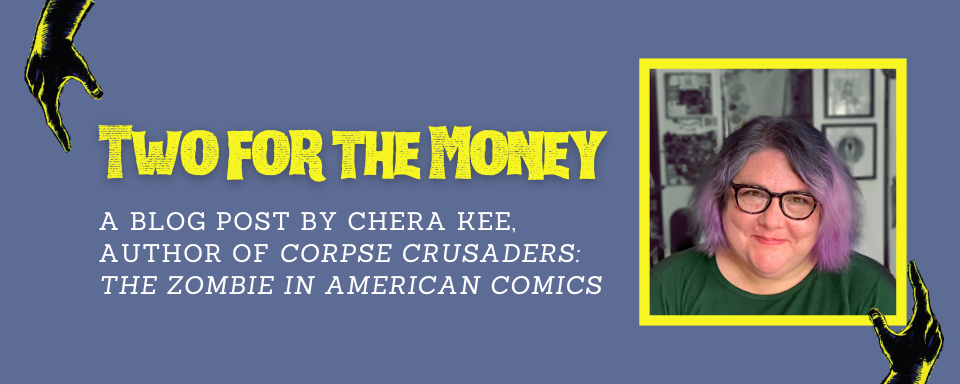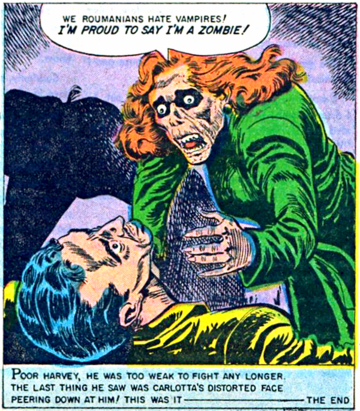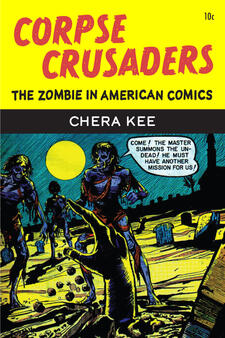Two for the Money

This guest post is written by Chera Kee, author of the new book Corpse Crusaders: The Zombie in American Comics, from the University of Michigan Press. The book is being published this July in hardcover, paperback, and Open Access.
The darkly playful story “Two for the Money,” published in Mysterious Adventures #22 in October 1954, opens with a man cowering from a vampire. She has blank eyes, sharp ears, even sharper teeth, and a very ample bosom—but this is a 1950s horror comic. A reader familiar with the genre would’ve known right away that this isn’t a seductive vampire. Rather, she’s here to mete out justice, and this opening panel is a clue that we’re about to read one of the more popular horror formulas of the era: what goes around, comes around.
While horror comics in the U.S. became increasingly gruesome and spectacular in the early 1950s, they usually had a strong moral compass: bad people were punished. It was just that instead of superheroes or police officers saving the day, it was often vampires and zombies. In my new book, Corpse Crusaders: The Zombie in American Comics, I explore this curious combination of the monstrous and the morally upright, alongside the ways that superheroic and action/adventure tropes have had a lasting impact on the undead in comics.
When we think of zombies, we usually imagine abject creatures, stripped of their free will. Today’s zombies are usually decomposing corpses driven by the need to eat human flesh, but even before the “cannibal” zombie became popular, zombies in American media were often slaves caught under the power of a zombie master who dictated their every move. Yet, it is precisely because of the zombie’s abject status—its inability to fully inhabit the “human”—that it can also serve as a progressive figure. In films and on television, zombies have often been made to stand in for disenfranchised or exploited bodies: the zombie’s status as both human but also not makes it an ideal vehicle for exploring the de-humanization of others. However, this often depends on a strange sort of zombiness that departs from the typical mindlessness one might expect. Thus, we tend to get a lot of sympathetic zombies—zombies audiences can root for—and U.S. media is full of zombies who talk, think, and even lead rebellions.
Corpse Crusaders explores zombies in U.S. comics, who, like the zombies shambling across tv and movie screens, have far more free will than we might expect. From almost the very beginning of their tenure in comics, there have been talking zombies, thinking zombies, and even zombie heroes. And those zombies are the focus of the book because while the talking, thinking zombies of films and tv are often disruptive figures who are pushing back against the status quo, zombies in comics are quite different.
Over the years, there have certainly been zombies in comics who were henchmen or slaves or hungry cannibal hordes out to eat the living, but there have also been a surprising number of zombies who exist to bring order to the world. From the first zombie superhero, The Purple Zombie, who appeared in the early 1940s, up through such characters as David Kim, the Xombi, from the 1990s Milestone title of the same name, and Gwen Dylan of iZombie, which was first published in 2010, zombies in comics have often served a surprisingly conservative function.
And that brings us back to “Two for the Money.”
If you remember, the first panel of the story has a man cowering from a vampire. He is Harvey Craig, “a smooth operator: his good looks and charm made his life as a gigolo quite simple.” Harvey likes to romance wealthy women, marry them, and then bask in their fortunes until the money runs out. In “Two for the Money,” Harvey actually finds two wealthy women to woo. He decides to marry them both, living a rich double life with wives “at opposite ends of the city.”
But the good life is a bit too good, and Harvey starts gaining weight from all the gourmet meals he’s been having. When he decides he wants to lose weight and announces his intention to start a diet, though, wife #1 isn’t pleased. Ilka Habor, “a Hungarian immigrant…who had been in America only two years,” seems troubled, and later that night, she attacks Harvey. He discovers she is a vampire, and she tells him, “You sound so surprised, darling…but it’s NOT strange, dear! Many Hungarian women are VAMPIRES!” She tries to kill him, but Harvey flees across town to his other wife.
Yet. Harvey worries: he realizes that Ilka had been fattening him up so she could feed on him. His other wife has also been feeding him well. Could she be a vampire too? Wife #2 is Carlotta Bartok, “an ex-Roumanian [sic] countess,” whose “fat checkbook” had “increased her desirability” with Harvey when they first met. He decides to test Carlotta, so he talks about a book he’s been reading on Hungarian vampires. Carlotta says, “How HORRIBLE! Those Hungarians are RIDICULOUS!” Harvey relaxes. Later, Harvey mentions his diet. Carlotta doesn’t seem disturbed, so Harvey is content to drift off to sleep, only to wake up a few hours later when he feels “two hairy hands near his neck.” He screams, “YOU ARE A VAMPIRE! You (GASP) You tricked me!” To which Carlotta replies, “I am NOT a vampire…They’re Disgusting! Thoroughly Disgusting!” In the final panel, as Carlotta leans in to kill her husband, she reveals, “We Roumanians [sic] hate vampires! I’m proud to say I’m a zombie!”
This comic is a great illustration of the sort of eye-for-an-eye morality of many horror comics in the 1950s, where if you did bad things, they would come back to haunt you. Yet, for a lot of adults, the morality plays going on in these stories were overshadowed by the gruesome monsters and bright gory covers of these comics. They assumed that the blood and gore meant that these comics were teaching children bad behaviors. This led to congressional hearings on comics in 1954, which in turn led to industry-wide censorship that would virtually eliminate horror comics for nearly two decades.
Of course, while the fears that comics monsters were acting monstrously might have been overblown, that doesn’t mean that these comics were without troubling material. One of the most glaring issues in “Two for the Money” is its use of immigrant women as Harvey’s monstrous wives. American horror has a long history of associating the foreign with danger or strangeness, and European characters—even if they weren’t vampires and zombies—have often been used to show the stark differences between the Old World and the New, suggesting that the U.S. has somehow surged ahead of its European counterparts in moving away from traditional beliefs and superstitions. This, of course, feeds into ideas of the U.S. as a land of progress, yet it also warns Americans of the dangers of the foreign.
“Two for the Money” fits this pattern, but it also came out during the McCarthy era at the height of the Red Scare, so turning a Hungarian woman and a Romanian woman into a vampire and a zombie respectively, makes sense as part of that discourse too. These women thus illustrate two kinds of outside threat—one that trades on traditional associations of the foreign with barbarity and another based on fears borne of the Red Scare that associate the foreign with threats to democracy.
While “Two for the Money” only has one zombie, it is still one of my favorite stories of the Golden Age of comics (1930s-1954). Not only does Harvey get his comeuppance, but we have a proud zombie woman doing it. Carlotta-the-zombie is a wonderful illustration of both the more conservative uses to which zombies could be put in comics of the 1950s and the ways that zombiism could help signpost difference. And while she might not seem very superheroic, Carlotta’s situation—enacting justice but doing so from the “outside”—is very much in line with what superheroes often experience in comics.
In fact, as I show in Corpse Crusaders, the lines between zombies and superheroes are often very thin. For both characters, there is usually some sort of transformative experience re-creating them as zombie or superhero, and both figures represent something that shouldn’t be: the perfect human body with extraordinary powers or the dead body returned to life. They are both the regular human made strange. Yet, because the earliest zombies in comics were typically found in superhero and action adventure titles—horror didn’t really become a stand-alone genre in comics until the late 1940s—the zombie in comics was also influenced by superheroic logics, and as such, its rebellious potential to disrupt the mundane world was largely sidestepped, and we find zombies working to put the world back together again rather than taking it apart.
That is perhaps the most compelling thing about “Two for the Money.” While traditionally, in films of the 1930s, ‘40s, and ‘50s, the monster was dispatched at the end—its threat neutralized, often by its death—in “Two for the Money,” the monsters live to kill again. And this is the truly radical thing about the story: Ilka and Carlotta are ultimately acting for the moral good—shutting down a conniving gigolo— but unlike most of the zombies of the 1950s, these two women haven’t returned to the grave. They are free to marry again: while Harvey may have deserved their attacks, will the next men they marry?
So, reader: beware! There are a lot of proud zombies out there just waiting for you to notice them. Do you dare take a chance on the next beautiful woman you meet?
References
“Two for the Money,” Mysterious Adventures #22 (Story Comics, Inc., Oct. 1954).




